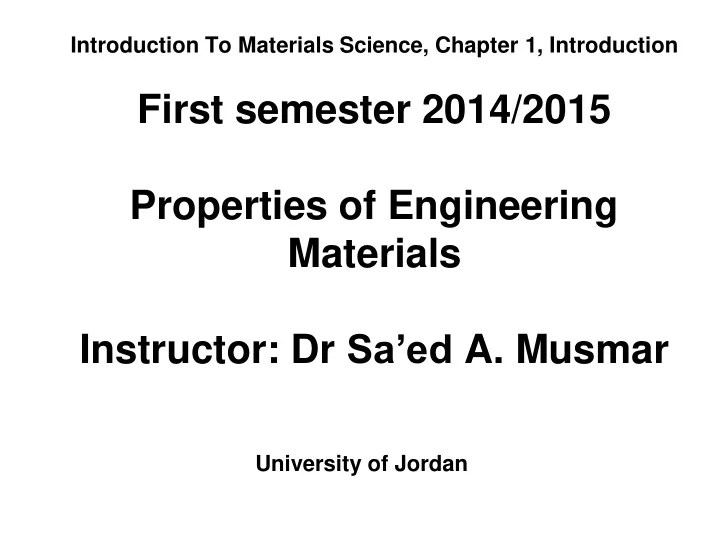

Introduction To Materials Science, Chapter 1, Introduction First semester 2014/2015 Properties of Engineering Materials Instructor: Dr Sa’ed A. Musmar University of Jordan
Grading: First Exam: 25% Second exam: 25 % The final exam: 50% Tests: pledged, closed-book and closed-notes Textbook: W. D. Callister, Materials Science and Engineering: An Introduction (John Wiley latest edition) I will also post my lecture notes on the web.
Syllabus : Types of materials (metals, ceramics, polymers, semiconductors) Properties of materials (mechanical, thermal, electrical, optical) Different levels of structure in materials (atomic, microscopic, macroscopic) Relation among material processing, structure, properties, and performance The main objective is to understand the basic concepts and language of Materials Science
Chapter Outline • Historical Perspective Stone → Bronze → Iron → Advanced materials • What is Materials Science and Engineering ? Processing → Structure → Properties → Performance • Classification of Industrial Materials Metals, Ceramics, Polymers, Semiconductors • Advanced Materials Electronic materials, superconductors, etc. • Modern Material's Needs, Material of Future Biodegradable materials, Nanomaterials , “Smart” materials
Historical Perspective • Beginning of the Material Science - People began to make tools from stone – Start of the Stone Age about two million years ago. Natural materials: stone, wood, clay, skins, etc. • The Stone Age ended about 5000 years ago with introduction of Bronze in the Far East. Bronze is an alloy (a metal made up of more than one element), copper + < 25% of tin + other elements. Bronze: can be hammered or cast into a variety of shapes, can be made harder by alloying, corrode only slowly after a surface oxide film forms. • The Iron Age began about 3000 years ago and continues today. Use of iron and steel, a stronger and cheaper material changed drastically daily life of a common person. • Age of Advanced materials: throughout the Iron Age many new types of materials have been introduced (ceramic, semiconductors, polymers, composites…). Understanding of the relationship among structure, properties, processing, and performance of materials . Intelligent design of new materials.
A better understanding of structure-composition-properties relations has lead to a remarkable progress in properties of materials. Example is the dramatic progress in the strength to density ratio of materials, that resulted in a wide variety of new products, from dental materials to tennis racquets.
What is Materials Science and Engineering ? • Material science is the investigation of the relationship among processing, structure, properties, and performance of materials. Processing Materials Optimization Loop Structure Properties Observational
Structure • Subatomic level (Chapter 2) Electronic structure of individual atoms that defines interaction among atoms (interatomic bonding). • Atomic level (Chapters 2 & 3) Arrangement of atoms in materials (for the same atoms can have different properties, e.g. two forms of carbon: graphite and diamond) • Microscopic structure (Ch. 4) Arrangement of small grains of material that can be identified by microscopy. • Macroscopic structure Structural elements that may be viewed with the naked eye.
Length -scale • Angstrom = 1Å = 1/10,000,000,000 meter = 10 -10 m • Nanometer = 10 nm = 1/1,000,000,000 meter = 10 -9 m • Micrometer = 1 μm = 1/1,000,000 meter = 10 -6 m • Millimeter = 1mm = 1/1,000 meter = 10 -3 m Interatomic distance ~ a few Å A human hair is ~ 50 μm Elongated bumps that make up the data track on CD are ~ 0.5 μm wide, minimum 0.83 μm long, and 125 nm high
Properties Properties are the way the material responds to the environment and external forces. • Mechanical properties – response to mechanical forces, strength, etc. • Electrical and magnetic properties - response to electrical and magnetic fields. Such as, conductivity, etc. • Thermal properties are related to transmission of heat and heat capacity. • Optical properties include to absorption, transmission and scattering of light. • Chemical stability in contact with the environment -corrosion resistance.
Types of Materials Let us classify materials according to the way the atoms are bound together (Chapter 2). • Metals : valence electrons are detached from atoms, and spread in an 'electron sea' that "glues" the ions together. Strong, ductile, conduct electricity and heat well, are shiny if polished. • Semiconductors : the bonding is covalent (electrons are shared between atoms). Their electrical properties depend strongly on minute proportions of contaminants. Examples: Si, Ge, Ga, As. • Ceramics : atoms behave like either positive or negative ions, and are bound by Coulomb forces. They are usually combinations of metals or semiconductors with oxygen, nitrogen or carbon (oxides, nitrides, and carbides). Hard, brittle, insulators. Examples: glass, porcelain. • Polymers : are bound by covalent forces and also by weak van der Waals forces, and usually based on C and H. They decompose at moderate temperatures (100 – 400 o C), and are lightweight. Examples: plastics, and rubber.
Future of materials science Design of materials having specific desired characteristics directly from our knowledge of atomic structure. • Miniaturization: “Nanostructured" materials, with microstructure that has length scales between 1 and 100 nanometers with unusual properties. Electronic components, materials for quantum computing. • Smart materials: airplane wings that deice themselves, buildings that stabilize themselves in earthquakes… • Environment-friendly materials: biodegradable or photodegradable plastics, advances in nuclear waste processing, etc. • Learning from Nature: shells and biological hard tissue can be as strong as the most advanced laboratory-produced ceramics, mollusces produce biocompatible adhesives that we do not know how to reproduce… • Materials for lightweight batteries with high storage densities, for turbine blades that can operate at 2500 ° C,room-temperature superconductors? chemical sensors (artificial nose) of extremely high sensitivity,……
Recommend
More recommend